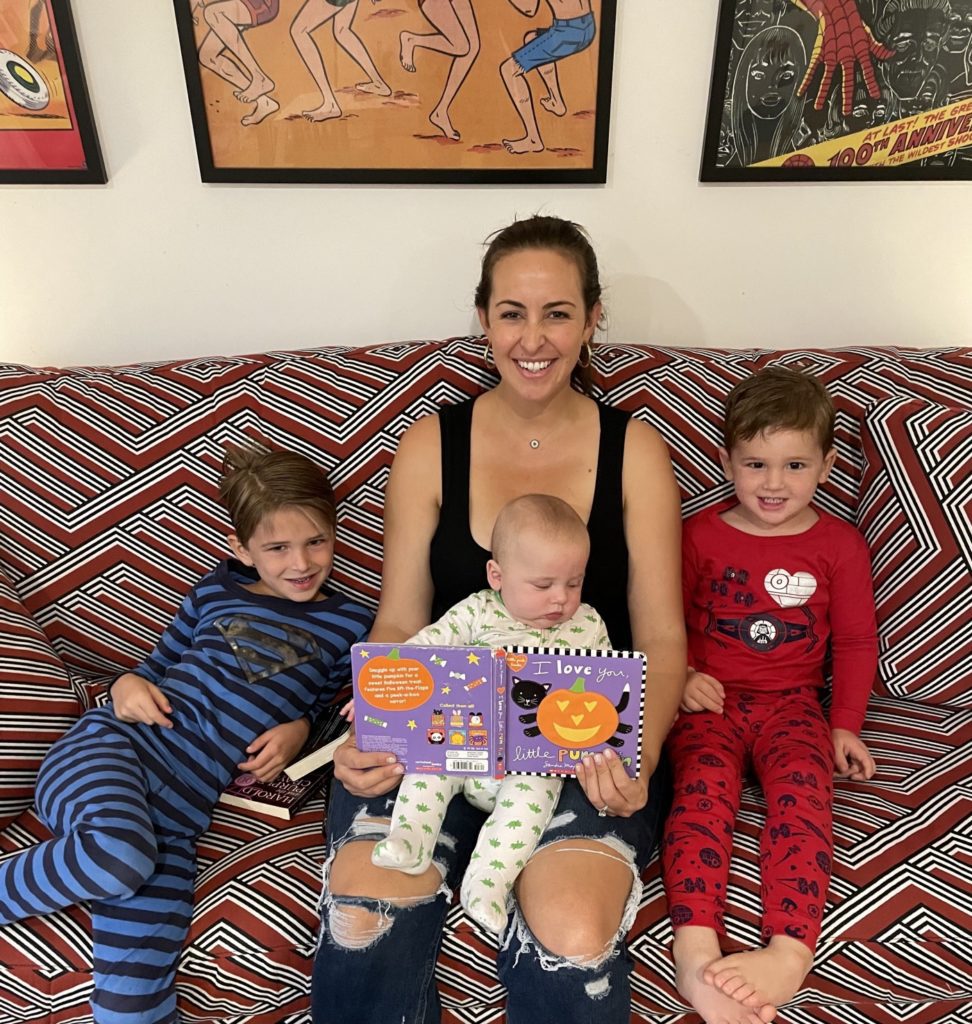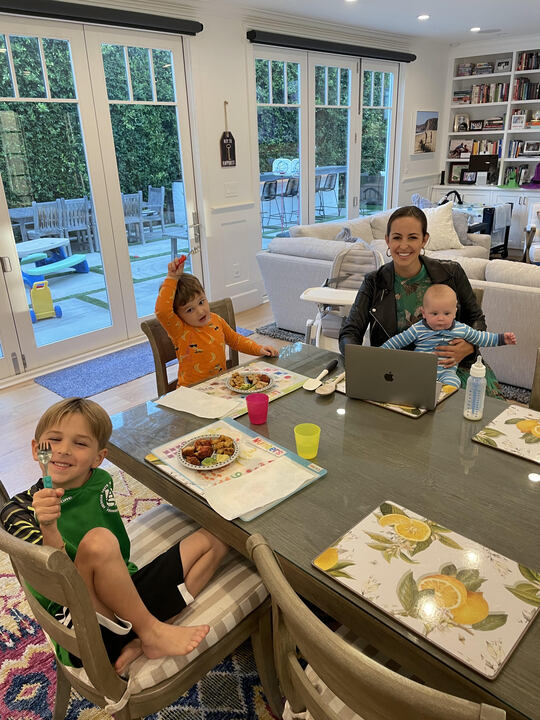
All I could think was, I failed my team, the majority of which is female.
A couple of weeks ago, I went to my first in-person dinner for work in a long time. (Yes. It was outdoors, and everyone was doing their part to be extremely cautious). It was a group of working women and mothers in the tech industry to hear activist & author Eve Rodsky moderate a roundtable discussion on gender equality from equal pay to equal parenting. The conversation quickly turned personal.
A friend and partner at a well-known law firm stood up and told a story: a male partner had asked her upon finding out that she was newly pregnant, ‘Will you be taking the WHOLE maternity leave?’ To which she responded, ‘Why wouldn’t I? It’s a WHOLE baby!?” She quickly found out she was the first female partner ever to do this at her firm — a firm with over 1000 employees.
What I realized upon hearing this, having fundraised through three pregnancies and never taken a maternity leave at all, I had failed my team. I had set an unintentional precedent for maternity leave policy at Halogen VC, where our focus and mission is to invest in women. I had fundraised through 3 separate pregnancies. And made it look possible (which it isn’t).
Juggling two full-time jobs is really hard
My friend went on to share her advice for other women, ‘Take the whole maternity leave. We all have to take the whole maternity leave.’ By standing up and taking the leave, it becomes more normal in what is not a ‘maternity leave’ friendly world. It was a triggering topic for me. I’m sure other women who are raising a family, regardless of whether you work in addition to the full-time job of being a mom, can relate. There are so many emotions: guilt, shame, loneliness, resentment, I could go on.
I’m sharing my personal experience because I want to give hope to all the struggling women and moms, and more importantly, I want to find real solutions for these problems. Problems that have been present for a hundred years but have been brought to life and amplified during the pandemic. Let me be clear. As one colleague said to me, ‘Childcare is a hot topic right now,’ to which I retorted, ‘No, it’s a CRISIS, not a trend, not a hot topic!’ It’s a national emergency we, as a society, across gender, age, race, etc., need to do everything we can to fix and fast.
I’ve seen it on pitch meetings, with toddlers popping up in zoom backgrounds with embarrassed parents quickly turning the video off and throwing their well-rehearsed pitches off-kilter. I’ve seen it in board meetings, with founders who would have normally met me in person dialing in over the phone, staying muted while balancing varying shades of chaos in the background. I’ve seen it in my friends’ lives, with some of them stepping back from the workforce, unable to manage it all, while others lamented missed career growth opportunities because they were essentially working two full-time jobs at once, as am I, as are so many of you.
The mass daycares like the well-known Bright Horizons are unaffordable in Los Angeles, ranging from $22,000 to 45,000 for children under 6. Forget college! Start saving for pre-school and daycare when you are 15. And also, make sure you are ready to be involved. Make sure you have extra time to help fundraise and do everything you possibly can for the school. I’ve missed picture day. I’ve been called out more than once by room moms and pre-school gala organizers for not contributing silent auction items, volunteering, or showing up for the Halloween parade. It’s brutal.
It’s an understatement to say that it’s cost-prohibitive for most American families to have children, let alone multiple children. In a country with a declining population growth rate and a clear-eyed view of what that means for its future status as a global economic superpower (ahem, nothing good), it seems we might be collectively motivated to fix this specific problem.
And yet.
Over 2.3M women left the workforce in just the first 10 months of the pandemic. That month, women’s participation in the workforce dropped to 57 percent, the lowest since 1988. And we know why. Everyone knows why. Because mothers take the brunt of it. No matter how 50/50 your relationship is and how much you have studied Eve Rodsky’s incredible book ‘Fair Play’ to level out your partnership, we know it’s because of the Moms.
And now, 18 months in, that number has been ticking up by the tens of thousands each month. And, as employers look ahead to a return either full-time in-office work or to hybrid workplaces, working mothers — many with inadequate childcare options in front of them — are the ones to feel the pinch of that shift.
The pandemic isn’t the root cause here
It’s just the magnifying glass that cracked the whole broken system open and exposed it for what it is. Think about this: Even pre-pandemic, a lack of access to childcare cost American families $37 billion in lost income and employers $13 billion a year in lost productivity — each year. It’s frustrating that I even have to type these words, but this isn’t something you can sideline as a women’s issue. This isn’t something that impacts only half the population, although women experience the brunt of the fallout. This is an American family issue. It’s a human issue. It’s a Dad issue. It’s a foster care issue. It’s a homelessness issue. And it’s a burning priority of an economic issue. Yes! These things are connected!
So, let’s quickly look at the underlying factors: First, care is too expensive for most working families to afford. According to the federal government, affordable child care shouldn’t exceed seven percent of a family’s income. In rural communities, with home care centers dominating but childcare deserts abounding, that looks more like 12 percent. In a heavily populated state like California, with extremely high real estate costs, that number goes up to nearly 25 percent. And for single parents, it comes to a staggering 34 percent.
But this equation is broken on both sides. Because at the same time, caregivers are often poorly compensated and struggle to make a living wage. Nearly 12 percent of child care workers live in poverty. On average, the true cost of providing quality child care is 42 percent more than what care providers charge families. It has become normalized for both the employer and employee to pay under the table due to lack of resources on both ends.
Some of that delta has to be covered by the federal government if we’re going to keep pace with the rest of the world. Trailing other developed nations in parental leave, universal childcare, and early education, the U.S. government has a lot of room for improvement when it comes to its role in subsidizing the cost of this necessary care. In fact, in America, parents pay nearly twice the average of Organization for Economic Cooperation and Development countries on childcare (Americans pay 23.1 percent of net income where the OECD average is 11.8 percent).
The next underlying issue is that there’s a real scarcity of quality childcare options in many, correction, most parts of the country. Even pre-pandemic, between 2018 and 2019, according to the non-profit Childcare Aware, “53% of states reported a decline in the number of child care centers…and 79% of states reported a decline in family child care (FCC) providers.” The pandemic has accelerated those closures in a way we won’t properly understand for another few years. Operating at slim margins, so many small child care centers and home daycares were forced to close, unable to ride out the uncertainty of shifting regulations and stay-at-home orders. Many of them won’t reopen, leaving already underserved communities with even fewer options.
And finally, there isn’t enough flexibility built into most childcare options to support working parents — and this again disproportionately impacts low-income families. After-hours, summer, and holiday care (known as wraparound care in the industry, meant to build around school calendars) are all cost-prohibitive additions that don’t fit into many families’ budgets. Why isn’t some form of school year-round? This is childcare for many families.
It’s time to disrupt childcare
These are deeply rooted challenges that aren’t going to be solved by one mom — no matter how much of a superwoman she is — or even just one employer. But a combination of government funding (child tax credits are a good start) and true disruption might be the answer. Companies like our portfolio company Weecare are creating affordable solutions with 2500 in-home and vetted childcare locations across the country. And the bet I’m really eager and ready to place is on the female founders who are looking to disrupt and reimagine a broken system. The visionaries who have already built companies in and around the childcare and family system that we work with like Hop Skip Drive, WeeCare, Brella,Caribu, and Binti. The ones who are obsessed with finding solutions to the problems they live and breathe every single day. The ones who are not just thinking about how hard everything feels right now, but seeing that there’s an opportunity for all of us to do better, for us to throw out the systems that don’t serve us and replace them with smarter, better, more efficient ideas.
Childcare is a significantly underserved opportunity, and as an investor, I see it as one of the most lucrative opportunities in the next 10+ years.
Venmo, Uber, and Airbnb, to name a few, came out of the 2008 recession. When people needed new ways to work and make money, they realized that individuals, peers, and communities could have more power than institutions. And those people and companies changed the way we live, travel, and work. They also drove billions of dollars in job creation and economic opportunity for consumers and investors alike. Imagine if they also had real childcare options back then, would they be valued higher?
The big, hairy audacious goal that will come out of this pandemic has to be finding a solution to the child care crisis. Again, it’s a crisis!
Because it’s millions of women and men hiding in closets screaming into the void. It’s parents perma-muted on zoom, nodding along as their coworkers pitch ideas while their household melts down in the background. It’s nannies, daycare workers, and other caregivers taking second jobs because their socially necessary first job doesn’t pay the bills. It’s 60 percent of rural Americans living in a childcare desert. And it’s parents, mostly women, giving up their future earnings potential by stepping away from the workforce because they don’t have a childcare option available that feels both safe and reliable — without exceeding their monthly paycheck.
Those are the problems. Now, what we need are solutions. Questions to ask: Could childcare-oriented salaries be tax free? Could every single corporation be required to offer some customized benefits so that they could be used for what you need? Is there a better solution for foster care? If we focus on solving foster care, will over 50% of the homeless be off of the street? (The answer is yes.)
And I’m betting on the female founders who are feeling the impacts of this crisis every day to find those solutions. These future billionaires don’t just have vision, grit, and a strategic point of view; they have skin in the game. And there’s nothing more powerful than that when it comes to building a business that can change the game — and the world.
Calling all fellow investors everywhere! Today, childcare is a $54B+ industry, with nearly a $1T impact on the economy. But looking into the future, the future of families is more like a $7.5T opportunity, according to the data our team at Halogen has collected. I’m excited to invest in this opportunity. I love space travel and rocketships and blockchain as much as the next investor, but childcare and the future of families is a trillion-dollar opportunity and needs innovation and solutions here on Earth. I’m excited at the potential to make real change by investing in childcare. However, I can’t do it alone. We need more funds pouring capital into this loving space.
And here’s one small thing you can do, take the whole maternity leave. By the way, Dad’s can take the whole paternity leave too.



